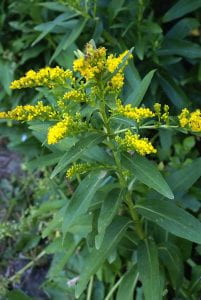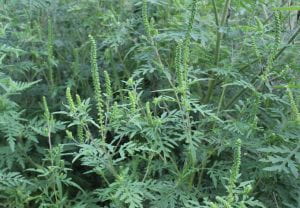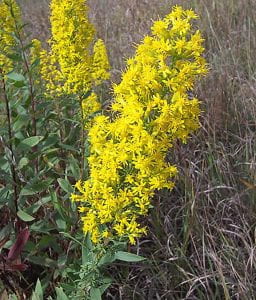By Linda Gayton, Highland Mills Master Gardener Volunteer
This article appeared in the August 2021 Issue of Gardening in Orange County.



Goldenrods are members of the aster family (Asteraceae) and most are of the genus Solidago. There are over two dozen species of goldenrod native to New York State varying in height from the 14 inch tall Alpine Goldenrod (Solidago leiocarpa) to the 4-6 foot Tall Goldenrod (Solidago altissima). Most of New York’s goldenrods are late bloomers putting out flowers in late summer and fall. As one of the few groups of wildflowers in peak bloom at this time, many insects depend on these plants for food. Goldenrods also provide food for birds and small mammals through their prolific seed production. On sunny days goldenrod patches are a good place to watch for butterflies including painted ladies, monarchs, and viceroys. In addition to butterflies, many species of bees, wasps, and beetles can also be seen collecting pollen and nectar from the hundreds of tiny flowers that make up a goldenrod’s inflorescence or flower head.

This hardy perennial thrives in a variety of habitats including roadsides, fields, wet and dry prairies, sandy banks, swampy bogs, and forest openings. Some species will even thrive in sand dunes by the ocean or on rocky summits. On the east seaboard, Seaside Goldenrod (Solidago sempervirens) grows in abundance stabilizing sand dunes and providing a vast food supply for monarch butterflies on their long migration south.
No matter your garden aesthetic, there is goldenrod for you. Gardeners who prefer tidy borders can choose clump forming varieties, whereas gardeners desiring a more naturalistic look may be able to accommodate the self-seeding or rhizomatous types. Most goldenrods are very hardy and vigorous with few diseases or insect problems. The spiky, fleecy, or sometimes flat-topped yellow flowers are versatile accents to the strong purples and pinks of aster, sedum, and joe-pye weed. They also complement dainty flowers of native grasses and lobelias.

For gardeners concerned about goldenrod’s alleged allergy inducing pollen, please note that goldenrod produces a sticky pollen meant to attract and adhere to insect pollinators not allergy inducing wind-borne pollen. One of the main culprits of late summer /early fall allergizes is ragweed, a common garden weed that blooms at the same time and often alongside goldenrod. Ragweed goes unnoticed in the landscape because of its drab green flowers, which generates an unusual amount of wind-borne pollen much to the chagrin of allergy sufferers. Goldenrod pollen will only affect an allergy sufferer if they stick their nose into a flower and take a big sniff.

Understanding this misconception between ragweed and goldenrod is important, as the goldenrods comprise a diverse genus with tremendous horticultural potential. Goldenrod is one of the absolute best native perennials for biodiversity. Add it to your pollinator gardens and let people know it is a friend, not a foe.
